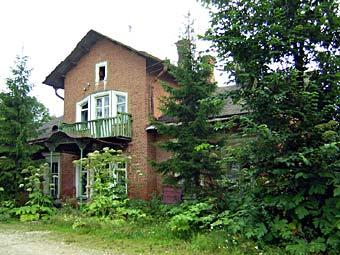Articles
/
Gostilitsi, a country estate
Gostilitsi, a country estate
Subject /
Architecture/Country estates
Gostilitsi, a country estate (the village of Gostilitsi, the Lomonosov district). It is an architectural sight of the 18th century. In 1721 Peter I granted the grange to Captain B.-Kh. Minikh which was invited for building the Ladoga Canals. On the River Gostilka the dam and series of weirs were constructed and an artificial lake was formed. On its right shore a wooden manor house and service buildings were built, on the left shore the village was located, a mill was built at the dam. In 1742 Minikh was in disfavour and was exiled to Siberia. In 1743 Empress Yelizaveta Petrovna presented the estate to her favourite A.G. Razumovsky. The manor house was rebuilt and enlarged, Cavalier blocks, the Hermitage and the church of the Holy Trinity were constructed. All buildings were made of bricks produced at the local factory. Works were realized according the projects of the architect A.V. Kvasov. The radical reconstruction of the palace was made in the later 18th century when General Field-Marshal K.G. Razumovsky, a younger brother of Aleksey Grigoryevich Razumovsky, became the owner of the estate. The new manor house in the style of "Palladian villa" with a semicircular rotunda over the cupola and a xyst that was leaned on the high cocle. Thr landscape upper park was relaid out, decorative constructions - the Tea pavilion, Small and Great grottos were built in it. In 1825 the estate passed into the ownership of A.M. Potyomkin who rebuilt a new palace in the English Gothic style (according to the project by the architect A.M. Shtakenshneider) in 1842-1845. The park was enlarged, cascades and fountains were made, new ponds were digged. Since 1872 estate owners often changed, after the Revolution of 1917 it was nationalized. In the period of collectivization (creation of collective farms in the late 1920's and 1930's) the kolkhoz "Gostilitsi" main farmstead was placed in Gostilitsi. During World War II a front line passed through Gostilitsi, the estate buildings and park destroyed. On present days the palace is ruined, some service constructions and the 100-year oak alley are intacted. The Trinity Church has been restored and passed to believers. М
Authors
Chekanova, Olga Aleksandrovna
Persons
Elizabeth Petrovna, Empress
Kvasov, Aleksey Vasilyevich
Munnich, Christofor Antonovich (Burhard Kristof), Count
Peter I, Emperor
Potemkin, A.N.
Razumovsky, Aleksey Grigoryevich, Count
Razumovsky, Kirill Grogoryevich, Count
Stakenschneider, Andrey Ivanovich
Geography
Leningrad Oblast, the/Lomonosov District/Gostilitsi Village
Topographical landmarks/Gostilka River, the
Topographical landmarks/Ladoga Canals, the
Bibliography
Мурашова Н.В. Сто дворянских усадеб Санкт-Петербургской губернии: Исторический справочник. СПб., 2005., 78-85
Subject Index
The Church of the Holy Trinity (Gostilitsy Village, Lomonosov District)
Mentioned in articles:
|
hidden
|
Country estates
Country estates. In the early 20th century on the territory of the modern Leningrad Oblast there were 2000 country estates. Mainly they appeared at one time with St. Petersburg. There were not many "Family nests" that belonged to one family and... more
|
|
|
|
hidden
|
Lomonosov District
LOMONOSOV DISTRICT. Area: 1990.8 sq. km. Population: 65,300. Established in 1927. L. D. comprises Bolshaya Izhora and Lebyazhye urban settlements and 140 rural localities. It borders St. Petersburg and Kingisepp, Volosovo, and Gatchina Districts of... more
|
|
|
|
hidden
|
Stakenschneider, Andrey Ivanovich (1802-1865), an architect
Stakenschneider, Andrey Ivanovich (1802, the grange of Ivanovka, the present days Gatchina District -1865), an architect, full state councillor (1858). He graduated the St. Petersburg Academy of Arts in 1821. From 1834 Stakenschneider was an... more
|
|
|
|









